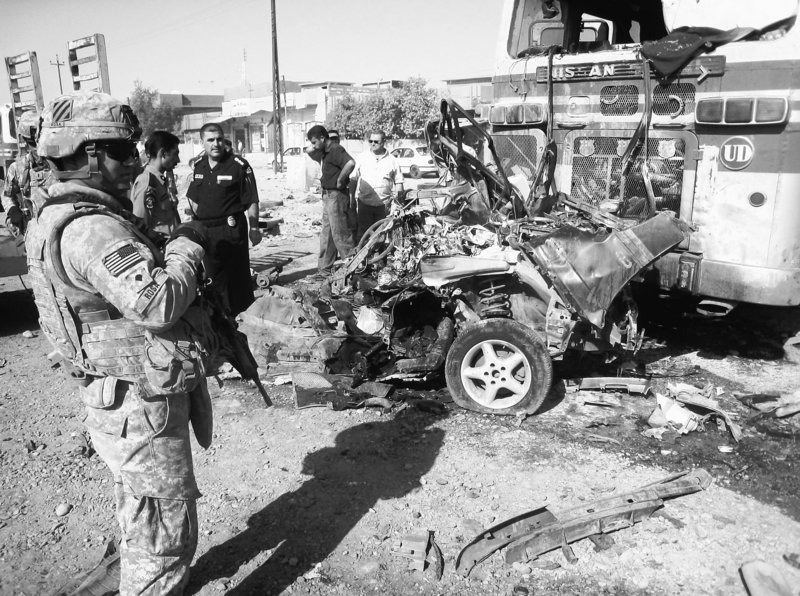CNN broadcast live feeds of the last combat brigade leaving Iraq earlier this month. But even with that news, the U.S. military commitment there is far from over.
While officially combat troops have been removed, it is hard to tell the difference in the eyes of the combat veterans still there. They are still in a hazardous location among a population that is sometimes hostile.
The U.S. military personnel in Iraq are assisting the Iraqi government, military and people to recover from the tyranny of a repressive regime. It is long and difficult mission to support. It has all of the indicators of turning into another location like Korea where the United States maintains a standing military presence.
As it currently stands, we are going to continue to have forces in Iraq for the near future. That is, as long as the U.S. Congress continues to support the commander in chief.
A similar situation exists in Afghanistan. There are nearly 100,000 military personnel in the country with a projected increase in U.S. military personnel. Like Iraq, the initial fighting ended years ago, but the insurgency continues.
Establishing the necessary security for a stable government requires at least a temporary increase in U.S. forces, according to our senior military leaders.
Given the past few years in Iraq as an example, the increase in forces should stabilize Afghanistan enough to allow the Afghan government to provide the services and support to its people it is required to do.
NOT GOING TO BREAK
As it currently stands, we are going to continue to have forces in Afghanistan for some time, again, so long as the U.S. Congress supports the Commander in Chief.
All of this, combined with our other commitments around the world, could make it seem as though the military is past it’s breaking point. In my opinion, it is not.
The U.S. military of today is not the same as the one that fought World War II, Korea or Vietnam. Those were wars with conscripts or national draftee armies. Victories for those kinds of armies require a definitive end. The people drafted and pressed into the defense of the nation need to have a distinct closure of hostilities.
World War II saw U.S. forces liberating countries, conquering and complete dismantling the aggressor countries and sending personnel back home. The American public generally thinks of as victory this way.
In Korea, the war ended in a stalemate at the 38th parallel. Most Americans do not consider it a lost war, only not a definitive victory.
Vietnam is considered a lost war, and it was. None of the political or strategic objectives were attained even though the United States did not lose a single operational battle.
However, the current military is an all-volunteer force, unlike the military of those earlier wars.
The army required to carry out a counter insurgency needs to be a predominately professional army. Both Iraq and Afghanistan are examples of how the military can conduct a major combat operation and counter-insurgency.
It is important to note that the National Guard and Reserves are a part of the professional force for the U.S. military.
Without its ability to expand the pool of trained, professional and competent personnel, the active-duty component would not be able to succeed. The National Guard and Reserves, in conjunction with the active component, are able to rotate through the persistent war zones without culminating.
LEARNING TO ADAPT
It has required some modifications to the military force regeneration cycle, but the military has adapted to the current situation. In my opinion, the military can continue the current level of operations for an extended time.
The question is no longer whether the military can maintain its current tempo. The U.S. military has settled into a rhythm that it can sustain.
It won’t be easy. Advances in medical knowledge and capability, technological advancements in equipment and relevant training have greatly increased our care for soldiers and their durability.
The U.S. military can and will continue current operations without breaking. The question is how much the people of the United States want to maintain current operations.
The people, through the power of the purse in Congress, determine how much they are willing to help the people of such nations as Iraq, Afghanistan, Pakistan and African nations.
Is it worth combating extremism abroad with U.S. forces or is it better to allow extremism to fester? There are people within our country and government on both sides of the question.
How the U.S. Congress votes will determine the answer, not the resilience of the U.S. military.
– Special to the Telegram
Send questions/comments to the editors.



Success. Please wait for the page to reload. If the page does not reload within 5 seconds, please refresh the page.
Enter your email and password to access comments.
Hi, to comment on stories you must . This profile is in addition to your subscription and website login.
Already have a commenting profile? .
Invalid username/password.
Please check your email to confirm and complete your registration.
Only subscribers are eligible to post comments. Please subscribe or login first for digital access. Here’s why.
Use the form below to reset your password. When you've submitted your account email, we will send an email with a reset code.